Aesthetics and why they matter – The Evergreen: A Northern Seasonal – Walker Ciancio
Introduction
When reading Edith Rinder’s three Breton folk tales “Amel and Penhor,” “Telen Rumengol,” and “Saint Efflam and King Arthur.” found in The Evergreen: a northern seasonal it’s easy to mistake their significance. These retold folktales appear to be simple legends found in a Celtic inspired “little magazine”. Yet when they are examined alongside their host The Evergreen specifically viewing the magazines aesthetics though the 1890’s fin de siècle looking glass, one can truly see the exquisitely designed cultural masterpiece that heavily impacted the Celtic revival.
With only four volumes and a runtime of two years, The Evergreen managed to make an enormous contributions to the Celtic revival. The four volumes, corresponding with each of the seasons, were expertly planned and heavily collaborated on. Rinder’s three Breton stories all follow this pattern, with each folktale embodying the themes of the season that the issue was based around as well as relating to the other works present in the issue. It is because of this community based design that The Evergreen: a northern seasonal was able to achieve such renown from the Celtic society.
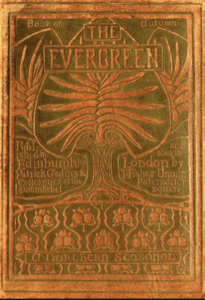
What was the Evergreen?
“Little magazines” are “avant-garde journals” that captivate the fin de siècle elements of the 1890’s Victorian time period. Popular examples include The Yellow Book, The Savoy, and The Evergreen. (Figure 1) Dubbed the “yellow nineties,” for the yellow books infamous influence, the time period was the beginning of the aestheticism movement. A period brought about by young scholars who realized that there wasn’t a “beautiful environment” (Koenraad Claes pg. 2) for them to express themselves safely for both feats of beauty and societal difference. While most of these political pieces focused on the modern Victorian, Peter Geddes’ The Evergreen influenced an entirely different people. Published by Peter Geddes and Collages, the Evergreen sot to be “a message of social regeneration” to achieve this they included works of art, science and a well-constructed theme that both enhanced and enticed the reader’s experience. The Evergreen: a northern seasonal was more than just a “Scottish yellow book.” (Kooistra, General Introduction) Geddes spawned a “radical revaluation of non-British culture that become known as the Celtic revival.” (Koenraad Claes pg. 161) Peter was always a man of means, purchasing a property in 1892, in what was called “Europe’s worst” slums Old Edinburgh Lawnmarket. The property Ramsay Lodge was to be a “home to university students, artists and intellectuals.” (Kooistra, General introduction) Geddes believed in “evolution based on cooperation,” (Cairns Craig 760-761) and by pouring his resources back into the land, he created a rich community focused on art and education, that became the “Old Edinburgh School of Art.” This school supplied creations of “stain glass and paintings for the outlook tower”, (Kooistra, General introduction) the place where The Evergreen was published. The once poor and desolate land was the sight for “urban renewal and revitalization” (Kooistra, general introduction) all because the community’s economy, that was once nonexistent, now had wealth and culture. The Evergreen tree was chosen for the cover as it represented “community”, further emphasizing Geddes vision of the importance of communal cooperation.
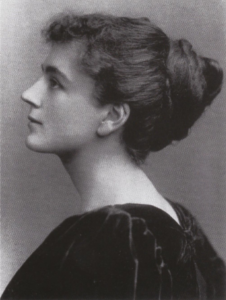
People of the Evergreen
Edith Wingate Rinder (Figure 2) was a woman ahead of her time, writer, poet and translator, Rinder worked on many personal projects and short stories, but has no renowned piece of work. One of the many colleagues that worked on the magazine was William Sharp. Ex-lover of Edith Rinder, William was a poet, political activist, and all together unique and intelligent man. Rinder herself was close to William, after they spent the early spring of 1890 together William “fell deeply in love with her.” (The Life and Letters of William Sharp and Fiona Macleod pg. 2) It was from the influence of Edith, Williams’s wife Elizabeth Sharp and his mother, that he created his ever so infamous alter ego, Fiona Macleod. Trained botanist Peter Geddes had a personal responsibility to the “interpenetration of art and science” (Kooistra, General introduction) from the passing of his wife he gained wealth that he used for his personal endeavors. In addition to his purchase of Ramsay Lodge, he also commissioned teachers and students at the School of Art to paint murals “featuring legendary battles and historic Scottish stories.” (Kooistra) As well as the stained glass windows that decorated the Outlook tower. These investments not only created last pieces of Celtic history, and funded the local economy but also educated the newest generation in the ways of Celtic art style and technique.
Stories from the seasons
The Evergreen success came from the collaborative planning. Each volume matched to one of the four seasons, the issues content followed the unique thematic concepts exclusive to each weathered season.
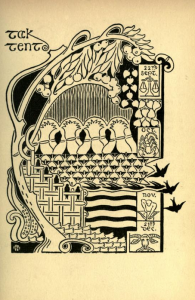
The stories moral is about personal sacrifice, and well as individual death, Amel gives his life first, showing the strength in personal sacrifice, Penhor then wishes just for her child safety giving her life for the potential survival of their child. In addition the story also mentions the
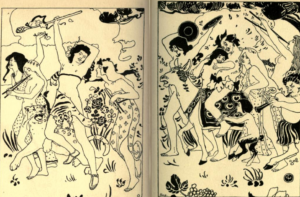
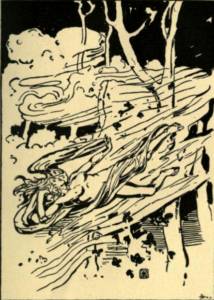
Volume 3 embodies summer, and with it themes of “song, sea, sex and sainthood” (Kooistra, Summer Introduction). The third issue has the largest quantity of artwork, both drawn and written. This follows suit with theme of song as the written pieces are almost all poetry.Summer carries with it the theme of water, known as the opposite of light and heat, water plays a large role during the summer as the only way to alleviate the burden of summer’s heat. Summer also represents themes of transition, death, and intensity. “Telen Rumengol” Rinders second folktale is about the King of Cornouailles. The King finds an ancient stone where the druids would worship god. Upon finding this place he declares that a temple shall be built here in the name of the Virgin Mary. However, before the temples completion the king passes, and ascends to heaven. There the virgin appears before him and thanks him for the beautiful temple, in return for this deed she offers him a favor. The King being a kind man only wishes for Mary to put a stop to his daughter who has turned evil, living below the water’s surface and using her voice and feminine visage to lure sailors to their death when the moon is full. Mary claims it is not in her power to do so, instead she creates a festival. This festival happens once a year and people from all over the islands come to sing and dance, which lulls the siren into a docile slumber.
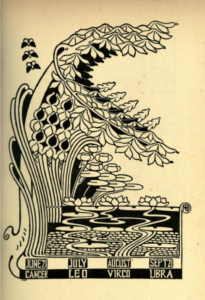
The celebration full of singing and dancing is an easy claim to the theme of song, the king’s daughter using her charms of seduction shows relation to sex and pleasure. While the connection to water comes from the daughters place of dwelling. Different pieces of work are shown in this issue, the almanac (Figure 6) is worth mentioning as it represents summer in its most obvious form. With the depiction of summer plants and butterflies as well as the small pound, the artwork shows summer as a cycled season. Water being a fundamental source of life for the plants growing from it, reiterating that bodies of water come with importance during this season.
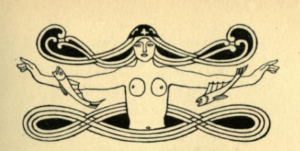
The headpiece (Figure 7) for the poem “I.-A Forerunner” by John Duncan depicts a bare breasted woman in a figure-eight of swirls, accompanied by two fish and flowing hair. The work seems like an artistic representation of a woman in the water, the fish representing the life given from the body and the swirls representing the water, and the naked woman for sex. “Bathers” (Figure 8) by Robert Burns is a simpler take on water. Depicting a woman in an outdoor bath, the theme of water here is about relief and cleansing instead of life giving.
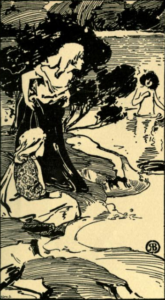
The last of Rinder’s tales is found in the final issue of The Evergreen: a Northern seasonal, volume 4, winter. “Saint Efflam and King Arthur” is a tale about a young noble boy who marries a fair and wealth princess of a faraway land. Her name was Enora and with her father’s blessing the two of them were wed. During that night Efflam left the castle followed only by his dog, and ventured out into the world. Pushed only by a divine vision, Efflam set out on a journey west, using a chest as a boat Efflam crosses the sea to the waste land of Amorica where dragons were said to rom the land. Fortunately for Efflam, it was winter when he arrived, so instead of dragons, he was met with crisp white snow making it difficult for navigation. This doesn’t pose a problem as he sees blood scattered on the snow. Efflam comes across a knight fighting a beast of a dragon. The Knight is losing but Efflam steps in grabbing a blade and striking the dragon down. The knight lays on the ground still, and it’s only when he brings a cup of water to the man’s lips does he awaken again. It’s revealed that he is King Arthur and they travel together for a time, Efflem leaves Arthur and settles on a hill where he lives the rest of his days as a saint with his wife Enora who joins him.
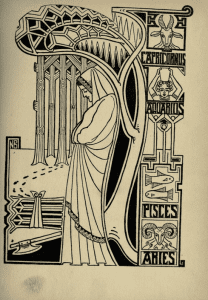
Winter has the darkest themes out of all the seasons. “Death, sleep, loss, remembrance and hope” (Kooistra, winter introduction) When King Arthur laid on the ground motionless it conjured themes of sleep and death, not knowing where he stood between the two. In addition, both Enora and Efflam died in their sleep, but not after giving hope to all who visited as they performed miracles to those in need. Seen as the most “mystical” of the seasons winter has the most “pagan-Christian blur”. The Almanac (Figure 9) for winter stands in opposition to the summer one, this piece displays a woman standing aside an arch of wood and snow. There she gazes at the ground with a somber but peaceful expression, this could be in relation to winter’s theme of hope or remembrance, as it’s during these times do we often look back at loved ones with a bitter sweetness.
Conclusion
With well-planned design and an ingenious community built around The Evergreen: a Northern seasonal. This “little magazine” brought about the Celtic revival to Irish, Scottish and Breton communities across the globe. Folktales were shown to be sources of cultural significance, as well as thematic tools to connect Celtic culture to literary work. The Evergreen: a northern seasonal had its impact on the Celtic revival because of its desire to be cohesive, and goal to be collaborative driven. Reinventing the slums of London, England, rebuilding a culture almost lost to the ages and producing one of the most artistically designed magazine of its time. Peter Geddes allowed art to take center stage in a way that was deemed “improper” and “occult” by modern Victorian standards. Showing that as long as you have community and culture, art and passion will always follow.
Bibliography:
Halloran, William F. The Life and Letters of William Sharp and “Fiona Macleod”. Open Book Publishers, 2018, ebookcentral-proquest-com.ezproxy.lib.ryerson.ca/lib/ryerson/reader.action?docID=5607107.
Julian, Hanna. “International Journal of Scottish Literature.” International Journal of Scottish Literature, 2011, www.ijsl.stir.ac.uk/.
Kooistra, Lorraine Janzen. The Evergreen: A Northern Seasonal (1895-97): Overview.” Evergreen Digital Edition, Yellow Nineties 2.0, edited by Lorraine Janzen Kooistra, Ryerson University Centre for Digital Humanities, 2018. https://1890s.ca/the_evergreen_general_introduction/
Kooistra, Lorraine Janzen. “Critical Introduction to The Evergreen: A Northern Seasonal Volume 2: Autumn 1895.” Evergreen Digital Edition, Yellow Nineties 2.0,edited by Lorraine Janzen Kooistra, Ryerson University Centre for Digital Humanities, 2018. https://1890s.ca/egv2_introduction/
Kooistra, Lorraine Janzen. “Critical Introduction to The Evergreen: A Northern Seasonal Volume 3: Summer 1896.” Evergreen Digital Edition, Yellow Nineties 2.0,edited by Lorraine Janzen Kooistra, Ryerson University Centre for Digital Humanities, 2018. https://1890s.ca/egv3_introduction/
Kooistra, Lorraine Janzen. “Critical Introduction to The Evergreen: A Northern Seasonal Volume 4: Winter 1896/7.” Evergreen Digital Edition, Yellow Nineties 2.0,edited by Lorraine Janzen Kooistra, Ryerson University Centre for Digital Humanities, 2018. https://1890s.ca/egv4_introduction/
McCulloch, Margery Palmer. Scottish Modernism and Its Contexts, 1918-1959: Literature, National Identity and Cultural Exchange. Edinburgh University Press, 2009.
Rinder, Edith Wingate. “Amel and Penhor.” The Evergreen: A Northern Seasonal, vol. 2, Autumn 1895, pp. 93-98. The Yellow Nineties Online, edited by Lorraine Janzen Kooistra, Ryerson University Centre for Digital Humanities, 2018. https://1890s.ca/egv2_rinder_amel/
Rinder, Edith Wingate. “Telen Rumengol.” The Evergreen: A Northern Seasonal, vol. 3, Summer 1896, pp. 90-97. The Yellow Nineties Online, edited by Lorraine Janzen Kooistra, Ryerson University Centre for Digital Humanities, 2018. https://1890s.ca/egv3_rinder_rumengol/
Rinder, Edith Wingate. “Sant Efflamm and King Arthur.” The Evergreen; A Northern Seasonal, vol. 4 Winter 1896-7, pp. 69-74. The Yellow Nineties Online, edited by Lorraine Janzen Kooistra, Ryerson University Centre for Digital Humanities, 2018. https://1890s.ca/egv4_rinder_sant/
